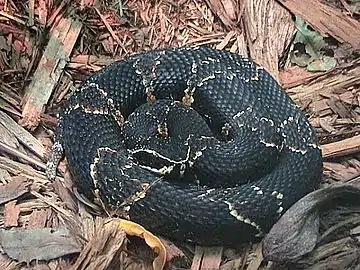Nuevo León
Nuevo León (Spanish pronunciation: [ˈnweβo leˈon] (![]() listen)), officially the Free and Sovereign State of Nuevo León (Spanish: Estado Libre y Soberano de Nuevo León), is one of the 32 states which comprise the Federal Entities of Mexico. It is divided into 51 municipalities and its capital city is Monterrey.
listen)), officially the Free and Sovereign State of Nuevo León (Spanish: Estado Libre y Soberano de Nuevo León), is one of the 32 states which comprise the Federal Entities of Mexico. It is divided into 51 municipalities and its capital city is Monterrey.
Nuevo León | |
|---|---|
| Free and Sovereign State of Nuevo León Estado Libre y Soberano de Nuevo León (Spanish) | |
 Flag  Coat of arms | |
| Motto(s): Semper Ascendens(Always Ascending) | |
| Anthem: Himno de Nuevo León | |
.svg.png.webp) State of Nuevo León within Mexico | |
| Coordinates: 25°34′N 99°58′W | |
| Country | Mexico |
| Capital | Monterrey |
| Largest City | Monterrey |
| Largest Metropolitan Area | Greater Monterrey |
| Admission | May 7, 1824[1] |
| Order | 15th |
| Government | |
| • Governor | Jaime Rodríguez Calderón (Independent) |
| • Senators[2] | Samuel Alejandro García Sepúlveda Indira Kempis Martínez Víctor Oswaldo Fuentes Solís |
| • Deputies[3] | |
| Area | |
| • Total | 64,156 km2 (24,771 sq mi) |
| Ranked 13th | |
| Highest elevation | 3,710 m (12,170 ft) |
| Population (2020)[6] | |
| • Total | 5,784,442 |
| • Rank | 8th |
| • Density | 90/km2 (230/sq mi) |
| • Density rank | 14th |
| Demonym(s) | Neoleonés |
| GDP (nominal; 2018)[7] | |
| • Total | $179.6 billion MXN |
| • Per capita | $35,081 MXN |
| GDP | |
| • Total | $197 billion |
| • Per capita | $36,140 |
| Time zone | UTC−6 (CST) |
| • Summer (DST) | UTC−5 (CDT) |
| Postal code | 64–67 |
| Area code | |
| ISO 3166 code | MX-NLE |
| HDI | |
| Website | Official Web Site |
It is located in Northeastern Mexico. It is bordered by the states of Tamaulipas to the north and east, San Luis Potosí to the south, and Coahuila to the west. To the north, Nuevo León has a 15 kilometer (9 mi) stretch of the U.S.–Mexico border adjacent to the U.S. state of Texas.
The state was named after the New Kingdom of León, an administrative territory of the Viceroyalty of New Spain, which was itself named after the historic Spanish Kingdom of León.
Besides its capital, other important cities are Guadalupe, Santa Catarina, San Nicolás de los Garza, and San Pedro Garza García, all of which are part of the Monterrey Metropolitan area.
History

Nuevo León was founded by conquistador Alberto del Canto, although frequent raids by Chichimecas, the natives of the north, prevented the establishment of almost any permanent settlements. Subsequent to the failure of del Canto to populate the area, Luis Carvajal y de la Cueva, at the head of a group of Portuguese and Spanish settlers who were of Jewish descent, requested permission from the Spanish King to attempt to settle the area which would be called the New Kingdom of León and would fail as well. It wasn't until 1596 under the leadership of Diego de Montemayor the colony became permanent. Nuevo Leon eventually became (along with the provinces of Coahuila, Nuevo Santander and Texas) one of the Eastern Internal Provinces in Northern New Spain.[9][10]
The capital of Nuevo León is Monterrey, the third largest city in Mexico with over four million residents. Monterrey is a modern and affluent city, and Nuevo León has long been one of Mexico's most industrialized states.
Geography

Nuevo León has an extreme climate, and there is very little rainfall throughout the year. The territory covers 64,220 square kilometres (24,800 sq mi), and can be divided into three regions: a hot, dry region in the north, a temperate region in the mountains, and a semi-arid region in the south. The Sierra Madre Oriental mountain range affects in an important way the lay of the land forming the Galeana and Doctor Arroyo plateaus, the Iguana, Picachos, Papagayos, and Santa Clara mountain ranges, and the Pilón, Ascensión, and Río Blanco valleys. As for hydrography, the San Juan River supplies the El Cuchillo dam, which provides water for Monterrey and the metropolitan area. There are also the Cerro Prieto, La Boca, Vaquerías, Nogalitos, and Agualeguas dams. Laguna de Labradores is a major lake in Nuevo León, and Pozo del Gavilán is a natural well. Both are located in the Galeana municipality. The flora of the region includes brush and pastures in the low regions, and pine and oak trees in the mountains. The fauna includes black bears, mountain lions, javelinas, prairie dogs, foxes, coyotes, and white-tailed deer, along with smaller species.
Demography
| Year | Pop. | ±% |
|---|---|---|
| 1895[11] | 311,665 | — |
| 1900 | 327,937 | +5.2% |
| 1910 | 365,150 | +11.3% |
| 1921 | 336,412 | −7.9% |
| 1930 | 417,491 | +24.1% |
| 1940 | 541,147 | +29.6% |
| 1950 | 740,191 | +36.8% |
| 1960 | 1,078,848 | +45.8% |
| 1970 | 1,694,689 | +57.1% |
| 1980 | 2,513,044 | +48.3% |
| 1990 | 3,098,736 | +23.3% |
| 1995 | 3,550,114 | +14.6% |
| 2000 | 3,834,141 | +8.0% |
| 2005 | 4,199,292 | +9.5% |
| 2010 | 4,653,458 | +10.8% |
| 2015 | 5,119,504 | +10.0% |
| 2020[12] | 5,784,442 | +13.0% |
As of 2020, Nuevo León's population was about 5.784 million. Of these over 90% of the state's population resides within the Monterrey Metropolitan area, making it the third largest metropolitan area in the country. Life expectancy in the state is high, being 73 years for men and 79 years for women.
Ninety-four percent of the total population occupy urban areas, one million of which are home-owners, and 98% have all utilities (running water, sewer systems and electric power). The remaining 2% is mostly the small indigenous population which is isolated and lives in the mountain regions.
Following the nation's tendency, a majority of the population identifies as being Roman Catholic.
Education

The high quality of life that prevails across the state is reflected on statistical rates such as education, as the entity reports an almost perfect record for finished secondary education, and 13 in 100 inhabitants earn a professional degree. In the same line, illiteracy rates for the state are within the lowest in the nation at 2.8%, just behind the Distrito Federal which still leads the country in this regard.
Institutions of higher education include:
- Instituto Tecnológico y de Estudios Superiores de Monterrey (ITESM)
- Universidad Autónoma de Nuevo León (UANL)
- Centro de Estudios Universitarios (CEU)
- Universidad Regiomontana (UR)
- Universidad Metropolitana de Monterrey(UMM)
- Universidad de Monterrey (UDEM)
- Centro de Estudios Superiores de Diseño de Monterrey (CEDIM)
Economy

Highly industrialized, Nuevo León possesses a standard of living similar to that of countries such as Croatia, Slovakia or Poland. In 2007, the per capita GDP of the state was similar to that of the Asian Tiger of South Korea and even higher than that of some European Union states such as Slovakia and Hungary. At about $27,000, it was the highest GDP per capita (PPP) of any Mexican state (not counting the Federal District, which also has a very high per capita), and was therefore higher than the Mexican national average (2013 GDP per capita (PPP) national average was $15,700).[13][14]
One of its municipalities, San Pedro Garza García, is among the richest in the country in terms of per capita income. It is also home of powerful conglomerates, such as Cemex (one of the largest construction materials firms in the world), Bimbo (bakery and pastry), Maseca (food and grains), Banorte (the only high-street bank in Mexico wholly owned by Mexicans), ALFA (Sigma, Alestra, Nemak, Alpek and Hylsa (recently bought by Ternium), i-service (HelpDesk), Vitro SA (glass), FEMSA (Coca-Cola in Latin America), and Cervecería Cuauhtémoc Moctezuma (brewers of Sol, Tecate, XX, Bohemia, Indio and Nochebuena).

Nuevo León also boasts a rich agricultural core, called the "orange belt", which comprises the municipalities of Allende, Montemorelos, Hualahuises, General Terán and Linares. Small but productive investments have been transforming traditional harvests (mainly based on orange and cereals) into agroindustrial developments that are producing increasing revenues for the local economy.
In contrast with the relative wealth of industrial Nuevo León and the orange belt, the Southern part of the state (municipalities of Galeana, Aramberri, Zaragoza, Doctor Arroyo and Mier y Noriega) remains rural and less productive. Most of The South of the state is at the mercy of a very dry weather that represents a major hurdle for agriculture and livestock.
As of 2010, Nuevo León's economy represents 11.4% of Mexico's total gross domestic product or US$165 billion.[15] Nuevo León's economy has a strong focus on export oriented manufacturing (i.e. maquiladora / INMEX). As of 2005, 431,551 people are employed in the manufacturing sector.[16] Foreign direct investment in Nuevo León was 1,213.1 million USD for 2005. In recent years, the state government has been making efforts in attracting significant investments in aeronautics, biotechnology, mechatronics, information and communication technologies fields with the creation of the Research and Technology Innovation Park PIIT (Parque de Investigación e Innovación Tecnológica), a technology park oriented in the development, innovation and research of sciences. The project is one of the key strategies within the Monterrey, City of Knowledge program. The park is located in the municipality of Apodaca, part of Greater Monterrey at the 10 km of the highway to Monterrey's International Airport. It consists of a total surface area of 70 Ha (172 acres), half of it already committed to R&D centers. The other 35 Ha (86 acres) are available for research and development centers, and for businesses that meet the Park's objectives.[17][18]
Government
| Nuevo León Gubernatorial Election 2003 | |
|---|---|
| PRI/PVEM | 24,567 |
| PAN | 491,973 |
| PT | 72,620 |
| PRD | 14,934 |
| NL Collections | 851,250 |
| See also: List of political parties in Mexico | |
- Official name
- Estado Libre y Soberano de Nuevo León (Free and Sovereign State of Nuevo León).
- Official motto
- Latin: Semper Ascendens (Always Ascending).
- Type of government
- Republican and representative according to 30th article of the local constitution.
- Executive
- In 6 July 2003 gubernatorial election, Alianza Ciudadana – an electoral alliance between the Institutional Revolutionary Party (PRI) and the Green Ecological Party of Mexico (PVEM) – regained control of the state from President Fox's party National Action Party (PAN). The new governor, Natividad González Parás of the PRI, was sworn in on 4 October 2003 for a period of six years.
- Cabinet
- Chosen directly by the Governor except for the General Comptroller and the State General Attorney, which are elected by Congress from a list of names provided by the Governor.
- Legislative
- The State has a unicameral chamber. The LXXI Congress of Nuevo León is composed of 42 deputies, 26 of them chosen by first-past-the-post electoral districts and 16 of them by proportional representation on a party-list basis. The parties represented are the PRI with 15 deputies, the PAN with 22 deputies, the Partido del Trabajo (PT) with two deputies, the Party of the Democratic Revolution (PRD) with one, and the New Alliance party (PANAL) with two deputies.
- Judiciary
- Judicial power rests in the Superior Court of Justice of Nuevo León, led by Minister Gustavo Adolfo Guerrero Gutiérrez.
- Political parties
- Official recognition is given by the State Electoral Commission to those parties getting more than 1.5% of the votes in the last election (Art.40 of the State Electoral Law), which are the ones represented in Congress.
Municipalities
Nuevo León is divided into 51 municipalities (municipios). See municipalities of Nuevo León.
Largest cities
| City | City Population[19] | Metropolitan Population[20] | Metropolitan area type |
|---|---|---|---|
| Monterrey | 1,135,550 | 4,570,577 | Municipality |
| Guadalupe | 678,006 | Part of Greater Monterrey | |
| Apodaca | 523,270 | ||
| San Nicolás de los Garza | 443,273 | ||
| General Escobedo | 357,256 | ||
| Santa Catarina | 270,790 | ||
| Juarez | 256,454 | ||
| García | 143,668 | ||
| San Pedro Garza García | 119,017 |
Climate
Nuevo León has many biomes, which is why it has different climates. Some areas in the mountains are very cold in winter and temperate in summer. In the northern part of the state the climate is arid as a result of the proximity to the Chihuahuan desert. Extreme high temperatures of 47 °C or more occur on the desert areas while winters are short and mild. In Monterrey the climate is hot semi-arid with extreme hot summers and mild winters. There is very little rainfall throughout the year, usually about 500 mm or less.
| Monterrey | ||||||||||||||||||||||||||||||||||||||||||||||||||||||||||||
|---|---|---|---|---|---|---|---|---|---|---|---|---|---|---|---|---|---|---|---|---|---|---|---|---|---|---|---|---|---|---|---|---|---|---|---|---|---|---|---|---|---|---|---|---|---|---|---|---|---|---|---|---|---|---|---|---|---|---|---|---|
| Climate chart (explanation) | ||||||||||||||||||||||||||||||||||||||||||||||||||||||||||||
| ||||||||||||||||||||||||||||||||||||||||||||||||||||||||||||
| ||||||||||||||||||||||||||||||||||||||||||||||||||||||||||||
| Anáhuac | ||||||||||||||||||||||||||||||||||||||||||||||||||||||||||||
|---|---|---|---|---|---|---|---|---|---|---|---|---|---|---|---|---|---|---|---|---|---|---|---|---|---|---|---|---|---|---|---|---|---|---|---|---|---|---|---|---|---|---|---|---|---|---|---|---|---|---|---|---|---|---|---|---|---|---|---|---|
| Climate chart (explanation) | ||||||||||||||||||||||||||||||||||||||||||||||||||||||||||||
| ||||||||||||||||||||||||||||||||||||||||||||||||||||||||||||
| ||||||||||||||||||||||||||||||||||||||||||||||||||||||||||||
Flora and fauna
| Flora and fauna of Nuevo León | |||||||
 |
 |
 |
.jpg.webp) |
 | |||
| Vulpes macrotis | Ursus americanus | Cardinalis cardinalis | Mephitis macroura | Aquila chrysaetos | |||
 |
 |
 |
 |
 | |||
| Cyanocitta stelleri | Pecari tajacu | Agkistrodon taylori | Tachybaptus dominicus | Antilocapra americana | |||
 |
 |
 |
 |
 | |||
| Carya illinoinensis | Dioon edule | Cercis canadensis | Aztekium ritteri | Pinus culminicola | |||
Media
Newspapers and news websites of Nuevo León include: ABC Noticias, Biznews, El Gráfico de Nuevo León, El Norte, El Porvenir, La Última Palabra, Medios Universitarios Diretec, Metro de Monterrey, Milenio Diario de Monterrey, Plataforma Mty. la ciudad que queremos, Publimetro, edición Monterrey, Regio.com, Reporte Indigo, Sòlo Ofertas.[21][22]
Twinning and covenants
The state has agreements with other states, provinces, regions and autonomous communities.[23]
Sources
- Human Development Report for Mexico 2002
- Historia de Nuevo León by Israel Cavazos (in Spanish)
- Enciclopedia de los Municipios de México (in Spanish)
- Comisión Estatal Electoral de Nuevo León (in Spanish)
- Ley Estatal Electoral de Nuevo León, 1996 (in Spanish)
References
- "Las Diputaciones Provinciales" (PDF) (in Spanish). p. 15.
- "Senadores por Nuevo León LXI Legislatura". Senado de la Republica. Retrieved March 29, 2010.
- "Listado de Diputados por Grupo Parlamentario del Estado de Nuevo León". Camara de Diputados. Retrieved March 28, 2010.
- "Resumen". Cuentame INEGI. Archived from the original on May 12, 2013. Retrieved February 12, 2013.
- "Relieve". Cuentame INEGI. Archived from the original on May 11, 2012. Retrieved March 30, 2011.
- https://www.inegi.org.mx/app/areasgeograficas/#tabMCcollapse-Indicadores
- Rodríguez, Guillermina (May 2019). "México - Indicadores Regionales de Actividad Económica 2019" (PDF). Banamex (in Spanish). Archived from the original (PDF) on 1 July 2019.
- "Report for Selected Countries and Subjects". www.imf.org. Retrieved 2019-10-19.
- Gerhard, Peter. The North Frontier of New Spain. Princeton, Princeton University Press, 1982.
- En los albores de la independencia: Las Provincias Internas de Oriente durante la insurrección de don Miguel Hidalgo y Costilla, 1810–1811. by Isidro Vizcaya Canales
- "Mexico: extended population list". GeoHive. Archived from the original on 2012-03-11. Retrieved 2011-07-29.
- https://www.inegi.org.mx/app/areasgeograficas/#tabMCcollapse-Indicadores
- INEGI, Población total por entidad federativa según sexo, 2000 y 2005 and PIB estatal
- Industrial Costs in Mexico – A Guide for Foreign Investors 2007. Mexico City: Bancomext. 2007. p. 96.
- Industrial Costs in Mexico – A Guide for Foreign Investors 2007. Mexico City: Bancomext. 2007. p. 92.
- "Research and Technology Innovation Park PIIT". Archived from the original on 2009-03-07.
- "Monterrey, city of knowledge". Mtycic.org. Retrieved 31 May 2018.
- "Instituto Nacional de Estadística y Geografía (INEGI)". Inegi.org.mx. Retrieved 31 May 2018.
- "2010 U.S. Census Data and Link to tables of population data from Census of 2010". Inegi.org.mx. Retrieved 31 May 2018.
- "Publicaciones periódicas en Nuevo León". Sistema de Información Cultural (in Spanish). Gobierno de Mexico. Retrieved March 7, 2020.
- "Latin American & Mexican Online News". Research Guides. US: University of Texas at San Antonio Libraries. Archived from the original on March 7, 2020.
- "Secretaría de Relaciones Exteriores - Gobierno - gob.mx". Sre.gob.mx. Retrieved 31 May 2018.
- "La Jornada: Los gobiernos de Nuevo León y Texas pactan impulsar la economía". Jornada.unam.mx. Retrieved 31 May 2018.
- "Firman acuerdo de colaboración gobierno de NL y Cataluña, España - INFO7". Info7.com.mx. Retrieved 31 May 2018.
- "Firman NL y Cataluña intercambio estratégico - INFO7". Info7.com.mx. Retrieved 31 May 2018.
- "Nuevo León y Cataluña, ¿tierras hermanas?". Publimetro México. Retrieved 31 May 2018.
External links
| Wikimedia Commons has media related to Nuevo León. |
 Geographic data related to Nuevo León at OpenStreetMap
Geographic data related to Nuevo León at OpenStreetMap- Nuevo León State Government (in Spanish)

